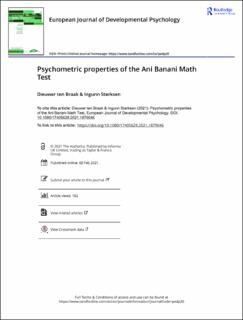| dc.contributor.author | ten Braak, Dieuwer | |
| dc.contributor.author | Størksen, Ingunn | |
| dc.date.accessioned | 2023-02-16T09:10:12Z | |
| dc.date.available | 2023-02-16T09:10:12Z | |
| dc.date.created | 2021-03-19T09:23:21Z | |
| dc.date.issued | 2021 | |
| dc.identifier.citation | ten Braak, D., & Størksen, I. (2021). Psychometric properties of the Ani Banani Math test. European Journal of Developmental Psychology, 18(4), 610-628. | en_US |
| dc.identifier.issn | 1740-5629 | |
| dc.identifier.uri | https://hdl.handle.net/11250/3051354 | |
| dc.description.abstract | This study assessed the psychometric properties of a digital early mathematics assessment, the Ani Banani Math Test (ABMT) in three samples (N1 = 243, N2 = 691, N3 = 1282) in kindergarten and first grade (age range 4.67– 7.30). Confirmatory factor analyses showed that the ABMT appears to measure one general construct of children’s informal mathematics development. MIMIC models showed that all items functioned similarly across age, socioeconomic status, and sex, except for two items which showed a bias towards boys and one item towards girls. The correlations with other mathematics assessments were strong, and significantly stronger than with executive function, working memory, and literacy measures, indicating concurrent and discriminant validity. The task was highly correlated with mathematics achievement five years later, indicating high predictive validity. Taken together, the ABMT appears to be a psychometrically valid research measure of children’s overall early mathematics skills; however, caution should be taken when comparing mean scores for boys and girls. | en_US |
| dc.language.iso | eng | en_US |
| dc.publisher | Taylor & Francis | en_US |
| dc.rights | Navngivelse 4.0 Internasjonal | * |
| dc.rights.uri | http://creativecommons.org/licenses/by/4.0/deed.no | * |
| dc.title | Psychometric properties of the Ani Banani Math Test | en_US |
| dc.type | Peer reviewed | en_US |
| dc.type | Journal article | en_US |
| dc.description.version | publishedVersion | en_US |
| dc.rights.holder | The authors | en_US |
| dc.subject.nsi | VDP::Medisinske Fag: 700 | en_US |
| dc.source.journal | European Journal of Developmental Psychology | en_US |
| dc.identifier.doi | 10.1080/17405629.2021.1879046 | |
| dc.identifier.cristin | 1899192 | |
| dc.relation.project | Norges forskningsråd: 237973 | en_US |
| dc.relation.project | Norges forskningsråd: 270703 | en_US |
| dc.relation.project | Norges forskningsråd: 203326 | en_US |
| dc.relation.project | Norges forskningsråd: 275576 | en_US |
| cristin.ispublished | true | |
| cristin.fulltext | original | |
| cristin.qualitycode | 1 | |

